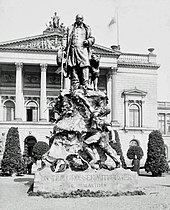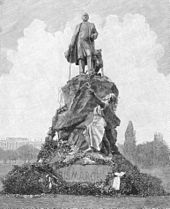Bismarck Monument (Leipzig)
The Leipzig Bismarck Monument was a monument in honor of Reich Chancellor Otto von Bismarck (1815–1898), which was erected from 1895 to 1946 in various designs and in different locations in Leipzig . Most of the time, the monument, which was designed by the sculptors Adolf Lehnert (1862–1948) and Josef Mágr (1861–1924), was on view in the Johannapark .
layout
The approximately 6 meter high concrete base was designed from a height of approximately one meter in the form of a steep rock cliff, on which oak branches rose on the left side. An iron blacksmith designed by Mágr, who was standing on the front to the right of the rock, with arms outstretched held a laurel wreath to Bismarck, who was standing on the base . The figure of the blacksmith allegorically referred to Bismarck as the “blacksmith of the German Empire ”.
In the first version of the memorial, which was unveiled on Augustusplatz in 1895 , the blacksmith, who was dressed in a simple robe, previously represented a young man who did not raise his second arm without a laurel wreath to Bismarck. The floor plan of the base was square and bore - apparently in reference to Bismarck's honorary citizenship of 1871 - the inscription UNSERM GROSSEN MITBÜRGER - DIE STALAKTITEN . From 1897 the dotted lettering BISMARCK could be seen on the front and 1897 on the back . After its final installation in Johannapark, smaller trees and bushes were planted around the base, framed by a low fence made of branches in concrete.
The statue of Bismarck himself, made of bronze by Lehnert , was shown standing on the pedestal with an open civilian coat. Bismarck's right arm was leaning on a walking stick, and he was also holding a hat in the hand itself. The other arm was bent forward. Links to Bismarck feet sat his as reichshund called Great Dane Tyras II .
The total height of the monument was about 9 to 10 meters (estimated from historical photographic recordings).
history

On the occasion of the 80th birthday of Otto von Bismarck , Chancellor of the German Empire until 1890 , the literary-artistic association Stalactites, founded in Leipzig in 1894, initiated an appeal for donations in 1895 to erect a memorial for Bismarck. Within a short period of time, so much financial means were available that it was ceremoniously unveiled on the night of April 1 of the year, the 80th birthday, on Augustusplatz in front of the New Theater , but initially in the form of a bronze plaster version and in different shape of the base and different lettering. The presentation of the monument quickly met with great approval among the people of Leipzig. The city of Leipzig proposed the Johannapark on the northwestern edge of the music district for the final location .
Here the monument was inaugurated in a modified form on October 18, 1897 opposite the monument presented on Augustusplatz, where it existed in this form for the next few decades. October 18th was the anniversary of the Battle of Nations and one day before the closing of the Saxon-Thuringian industrial and commercial exhibition , the main entrance of which was diagonally opposite the monument.
1942 of MAGR designed and about 1260-kilogram figure of the blacksmith as part of the action was "Metal donation for the leader" dismantled and for purposes of weapons production of the Nazis in the Second World War melted down. The memorial itself survived the bombing raids on Leipzig during World War II. In 1946, the monument was first overturned by an unknown hand and shortly afterwards it was finally removed. The sculpture designed by Walter Arnold (1909–1979) for Clara Zetkin (1857–1933) has been located at the place where the Leipzig Bismarck Monument was located .
useful information
- In addition to the Bismarck monument, there has also been a Bismarck tower in the Leipzig district of Lützschena-Stahmeln since 1915 .
- In 1915 the draft of a second Bismarck memorial stood in front of the New Town Hall for about 14 days .
Individual evidence
- ^ Illustrated newspaper. No. 2835 of October 28, 1897, Weber, Leipzig 1897
- ↑ stalactites. In: Leipzig Lexicon. Retrieved August 17, 2015 .
- ↑ Report on the acceptance of the monuments for the City History Museum (City Chronicle). [Typewritten manuscript of the building construction office / city planning office Leipzig dated October 6, 1942, Bibl.-Sign. City History Museum Leipzig: I G 292] . Leipzig 1942
literature
- Illustrated newspaper . No. 2835 of October 28, 1897, Weber, Leipzig 1897, pp. 579-580
- Administrative report of the City Council of Leipzig for the year 1897. Duncker & Humblot, Leipzig 1899, pp. 215–220
- Max Eschner: Leipzig's monuments, memorial stones and memorial plaques. With 81 full images. Wigand, Leipzig 1910
- Claus Uhlrich: Disappeared. Fate of Leipzig monuments, memorial stones and sculptures. Bachmann, Leipzig 1994
- Stefan Voerkel: The blacksmith of German unity. On October 3, 1995. In: Leipziger Blätter 1995, No. 27, pp. 79-80
- Claus Uhlrich: Majesty broke her legs ... And other stories about Leipzig monuments and sculptures. PRO Leipzig, Leipzig 2005

